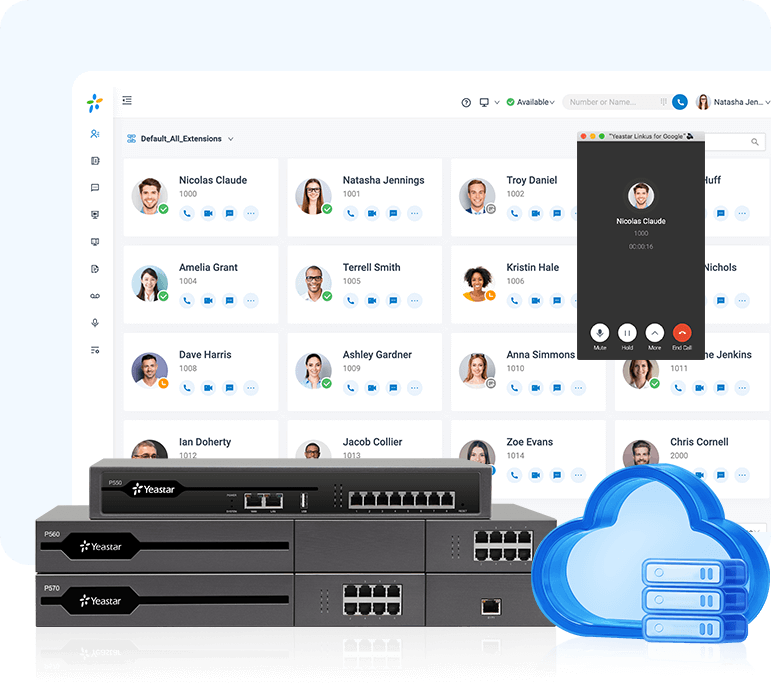
What is a VoIP Phone System?
A VoIP phone system is a business communications solution based upon VoIP technology. VoIP stands for Voice over Internet Protocol or Voice over IP, also known as IP Telephony.
VoIP enables voice communication over the internet instead of traditional phone lines. It operates by transmitting digital voice data packets over an IP network like the internet or a local area network (LAN).
How does a VoIP phone system work?
This internet-based system converts voice calls into digital data and transmits them via the network. Compared to conventional telephone systems, VoIP offers cost-effectiveness, efficiency, and a range of features such as call routing, voicemail, call forwarding, conference calling, and integration with 3-party applications.
VoIP solutions can be deployed in various ways, including on-premises setups, hosted/cloud-based services, or hybrid configurations. These options provide flexibility, scalability, and cost savings, making VoIP systems highly popular for businesses of all sizes.
Time to Upgrade: Traditional vs. VoIP Phone System
In the long run, IP telephony surpasses traditional analog ones in terms of functionality, flexibility, cost, and reliability. That's why businesses today are switching from landline phones to Internet-based phone system. If you're considering upgrading to VoIP or still doubt about the differences between a traditional phone system and VoIP, take a look at this straightforward table:
Aspect
Transmission Method
Infrastructure
Cost
Features and Flexibility
Scalability
Analog Phone System
VS
VoIP Phone System
Analog electrical signals
Digital data packets over IP
Dedicated copper lines
Existing internet infrastructure
Higher installation costs
Lower long-distance charges
Basic features
Advanced features and mobility
Requires physical lines
Easily scalable without changes
When to Consider Switching to a VoIP Phone System
Your business is expanding rapidly and requires the ability to easily add or remove lines.
You have long-distance or international calling needs and want to save on telecommunication expenses.
You have multiple office locations and need VoIP functionality to support hybrid working.
Your current infrastructure is outdated and maintenance costs are high.
Have to stay connected anywhere, at any time.
You require a powerful call center to improve response speed and enhance customer satisfaction.
You need to ensure disaster recovery and business continuity.
Choose Yeastar VoIP Phone System Because It's...
Easy to use
User-friendly interface and intuitive design make it easy to navigate and utilize without any technical complexity.
Flexible
On-premises or cloud-based deployment, Yeastar VoIP phone system offers options to suit all business needs.
Secure
Provide enterprise-level encryption and security mechanisms to ensure privacy and VoIP phone system security.
Reliable
Yeastar offers duel-server high availability setup with automatic failover to ensure little-to-no VoIP phone system downtime.
What You Can Expect for Yeastar VoIP PBX System
Yeastar isn't just a business telephony VoIP solution. It's a fully-featured system that offer a comprehensive suite of features that greatly enhance communication experiences for your business.
Abundance of VoIP Phone System Features You May Need |
|||
|---|---|---|---|
| Auto Attendant | AutoCLIP | Call Back | Call Flip |
| Call Forwarding | Call Recording | Call Monitor | Call Parking |
| Self-service IVR | Call Queue | ACD | More Features |
120+
Countries
450,000
Happy Customers
250,000
PBX Installed

See Yeastar VolP Phone System in Action?
Access all the features in no time with 30-day free trial of Yeastar P-Series IP Phone System.
Common FAQs About VoIP Phone System
.
Can I keep my existing number with VoIP?
.
The short answer is yes, you can bring your existing number over with you to Yeastar VoIP phone system. This process is known as number porting or number transfer, and it is super easy to complete. For specific instructions and assistance with the number porting, please contact us.
.
How much does VoIP telephone system may cost?
.
- Upfront Costs: Yeastar business phone systems seamlessly integrate with existing legacy PBX systems, allowing businesses to preserve their previous investments while moving to VoIP. This integration optimizes outgoing call routes, resulting in minimized fees and
significant reductions in long-distance charges. - Subscription Costs: Yeastar offers 3 different plans, each with a range of telephony features and add-on UC services. Download the datasheet to learn more.
- Operational Costs: The actual expenses may vary depending on your business model and the features included in the plan. If you decide to manage your own VoIP phone system, be sure to account for monthly electricity costs and any fees related to system maintenance.
- Upgrade Costs: With Yeastar phone systems, you’ll enjoy greater flexibility to add new users, expand system capacity, and adapt to changing communication needs. This means that as your business grows or requirements evolve, you can upgrade your system without
incurring significant additional costs.
In summary, the cost of VoIP phone service encompasses various factors. To obtain specific pricing details and identify the most suitable solution for your business, it is recommended to consult with Yeastar.
.
How many types of phone systems are there?
.
- Analog Phone System: The traditional analog phone system is typically found within an office setting. It utilizes physical phone lines to handle phone calls and even fax transmissions.
- IP Phone System (or IP PBX Phone System): Rather than using traditional phone lines, IP PBX uses the Internet protocol. It provides more additional VoIP features and may be a more cost-effective option.
- Cloud-based Phone System: The Cloud phone system is hosted in the cloud, eliminating the need for ecomplex infrastructure setup and maintenance. It is a full-featured system for business communications.
- Mobile Phone System: Mobile phone systems rely on cellular networks to transmit voice calls. They provide mobility and convenience, allowing users to make and receive calls from anywhere with network coverage.
It’s worth noting that these are just some examples, and advancements in technology continue to expand the options and capabilities of phone systems. The choice of phone system depends on specific needs, budget, and infrastructure requirements of an individual or organization.
.
Are VoIP phone systems reliable?
.
Yes, VoIP phone systems can be reliable when implemented and maintained properly. However, in terms of reliability, it can vary depending on various factors such as the quality of your internet connection, network infrastructure, and the service provider you choose.
To ensure reliability:
- Internet Connection: A stable and high-speed internet connection is crucial for reliable VoIP service. It’s important to have sufficient bandwidth to handle your call volume and minimize latency or packet loss.
- Network Infrastructure: A well-configured and properly maintained network infrastructure is essential for ensuring reliable VoIP communication. This includes routers, switches, firewalls, and other network components that support VoIP traffic.</span >
- Service Provider: Choosing a reputable VoIP service provider with a strong track record in delivering reliable service is crucial. Look for providers that offer robust infrastructure, redundant systems, and good customer support.
- Quality of Service (QoS): Implementing Quality of Service protocols on your network can prioritize and ensure consistent, high-quality voice traffic over other types of data traffic, enhancing reliability.
- Redundancy and Backup: Having backup power supplies, in addition, redundant internet connections, and alternative communication methods available can help maintain service continuity during outages or disruptions.
Is VoIP suitable for small business?
.
What should I consider when choosing a VoIP PBX?
.
- Compatibility with Existing Equipment
If you have a traditional PBX system and a limited budget, choose a VoIP solution that allows a phased transition. Make sure the new VoIP system is compatible with your existing one, and discuss how to connect them without affecting business continuity.
- Unified Communications (UC) Features
Look for UC capabilities such as unified messaging, instant messaging, presence indicators, corporate directories, video conferencing, and team collaboration tools. These features consolidate various communication channels into one access point.
- Integration with Other APPs
Choose a VoIP system provider that offers seamless integration with other business tools. This enhances efficiency, communication, collaboration, and streamlines workflows.
.

We’ve experienced the state-of-the-art call center features that other VoIP phone system can’t offer. Yeastar P-Series has never stopped to impress us.
X


